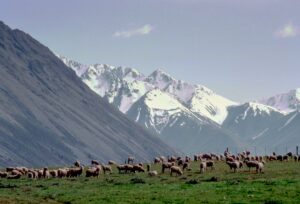Et landbrug som yder mere miljø uden at vi skal betale

Får på New Zealand. Et landbrug som trives uden støtte
The elimination of agricultural subsidies in New Zealand in the mid 1980s has had a range of sustainable
development-related effects. Drawing on a ‘three pillar’ (economic, environment and social) paradigm
of sustainable development, this article assesses some of the impacts of this subsidy reform 20 years after
it was launched. The economic and environmental effects are judged to have been broadly positive and
the short-term negative social effects were relatively muted. The case shows the shift over time away from the use of land for pasturing/grazing to forestry.In particular, the removal of subsidies for the development of marginal land into pasture forsheep grazing has meant that farmers have had less incentive to convert indigenous bush andother marginal land to other uses. Total area in various forms of pasture has declined from14.1 million hectares in 1983 – 1984 to 13.5 million hectares in 1995 and 12.1 million in2004 – 2005. Concomitantly, the area of planted forest has increased from 1.0 million in1983 – 1984 to over 1.8 million hectares in 2003 – 2004, a 50% increase, over the same period.
